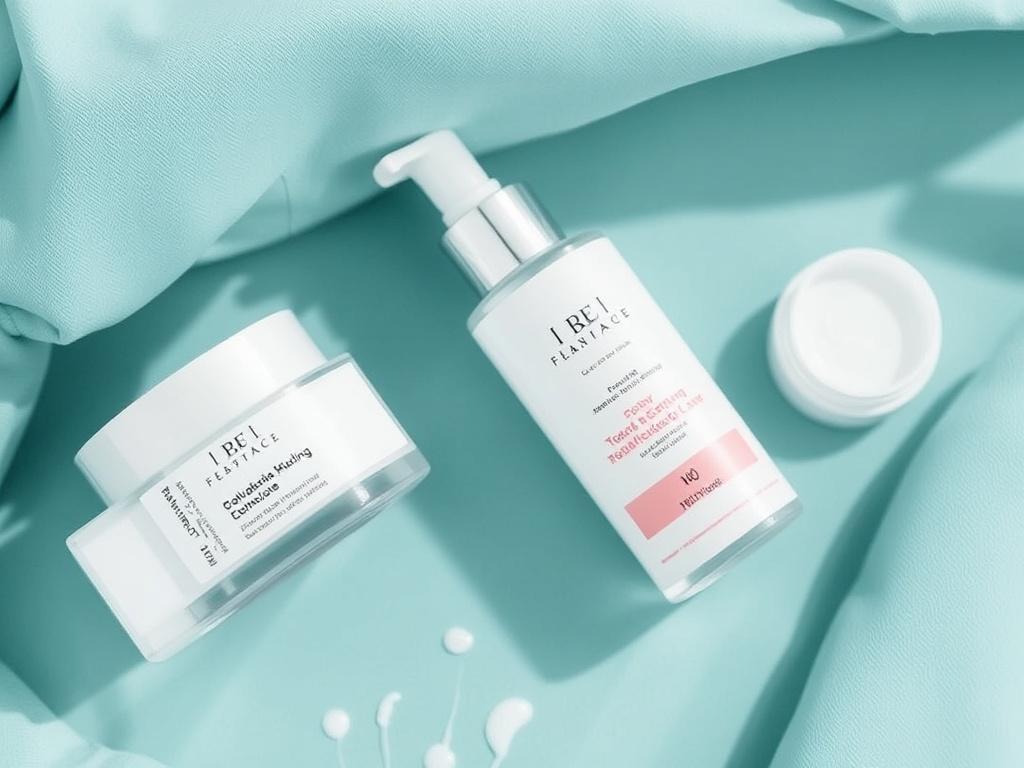Содержание статьи
- 1 What Is Rosacea? Understanding Your Skin’s Sensitivities
- 2 Identifying the Best Skincare Ingredients for Rosacea-Prone Skin
- 3 Building a Gentle Skincare Routine for Rosacea: Step by Step
- 4 Sample Rosacea-Prone Skincare Routine
- 5 Lifestyle Tips to Support Rosacea-Prone Skin
- 6 Expert Tips for Choosing Rosacea-Friendly Products
- 7 Popular Products Recommended for Rosacea-Prone Skin
- 8 Common Myths About Rosacea and Skincare
- 9 When to See a Dermatologist
- 10 Conclusion
Rosacea is a common but often misunderstood skin condition that can cause redness, inflammation, and visible blood vessels on the face. If you have rosacea-prone skin, finding the best skincare routine can feel like navigating a minefield. Harsh products, extreme weather, and even certain foods can trigger flare-ups, leaving your skin uncomfortable and your confidence shaken. But don’t worry—this comprehensive guide will help you understand exactly what rosacea is and how to care for your sensitive skin with the best skincare for rosacea-prone skin.
In this article, we’ll walk through the most effective ingredients, daily routines, and lifestyle tips to keep your skin calm and protected. Whether you’re newly diagnosed or have been battling rosacea for years, you’ll gain practical insights on how to manage your skin condition and feel comfortable in your own skin again.
What Is Rosacea? Understanding Your Skin’s Sensitivities
Before diving into skincare products and routines, it’s important to understand what rosacea actually is. Rosacea is a chronic inflammatory skin condition that primarily affects the face. It usually begins with persistent redness concentrated around the cheeks, nose, chin, or forehead. Over time, you might notice visible blood vessels, bumps, pimples, or a burning sensation.
The exact cause of rosacea isn’t fully understood, but experts believe it involves a combination of genetic and environmental factors. Triggers like sun exposure, extreme temperatures, spicy foods, alcohol, stress, and certain skincare products can aggravate the condition, leading to flare-ups.
Because rosacea-prone skin is highly sensitive and reactive, it requires a gentle approach to cleansing, moisturizing, and treatment that avoids irritation while strengthening the skin’s natural barrier.
Identifying the Best Skincare Ingredients for Rosacea-Prone Skin
When searching for the best skincare for rosacea-prone skin, ingredient choice is everything. Avoiding harsh chemicals or known irritants and focusing on gentle, soothing components can reduce redness and inflammation. Here’s a detailed breakdown of both the ingredients to avoid and those to seek out:
Ingredients to Avoid
- Alcohol (especially denatured or SD alcohol): Can dry out and irritate the skin.
- Fragrance and essential oils: Common causes of allergic reactions and irritation.
- Sulfates: Harsh cleansing agents that strip natural oils and disrupt the skin barrier.
- Benzoyl peroxide and salicylic acid: Effective acne treatments but often too harsh for rosacea skin.
- Physical exfoliants (like scrubs with crushed shells or beads): Can create microtears and exacerbate inflammation.
Ingredients to Look For
- Niacinamide: Improves skin barrier function and reduces redness.
- Aloe Vera: Calming and hydrating, helps soothe irritated skin.
- Green Tea Extract: Contains antioxidants and anti-inflammatory properties.
- Azelaic Acid: Specifically approved for rosacea, reduces redness and bumps.
- Chamomile: Provides gentle anti-inflammatory benefits.
- Ceramides: Help restore the skin’s natural barrier and lock in moisture.
- Hyaluronic Acid: Deeply hydrates without clogging pores.
- Zinc Oxide: Used in physical sunscreens, soothes and protects sensitive skin from UV rays.
Building a Gentle Skincare Routine for Rosacea: Step by Step
Creating an effective routine for rosacea-prone skin means simplicity and consistency. Choose gentle, fragrance-free products with calming ingredients and apply them in a way that supports skin health.
Step 1: Cleansing with Care
Cleansing shouldn’t feel stripping or irritating. Use a mild, soap-free cleanser designed for sensitive skin. Look for products labeled “fragrance-free” and “non-comedogenic.” Micellar water can be a good option if you prefer a no-rinse alternative.
Step 2: Hydrating and Soothing
After cleansing, apply a lightweight serum or moisturizer enriched with niacinamide, ceramides, or hyaluronic acid. These ingredients boost hydration while calming inflammation.
Step 3: Targeted Treatment
If your dermatologist has prescribed azelaic acid or metronidazole creams, use them as directed. Azelaic acid, in particular, has become a gold standard in rosacea management due to its anti-inflammatory and anti-microbial effects.
Step 4: Sun Protection
Sun exposure is one of the biggest triggers for rosacea flare-ups, so daily sun protection is essential. Physical (mineral) sunscreens containing zinc oxide or titanium dioxide are best because they are less likely to irritate sensitive skin compared to chemical sunscreens.
Sample Rosacea-Prone Skincare Routine

| Time of Day | Recommended Product Type | Key Ingredients | Purpose |
|---|---|---|---|
| Morning | Gentle cleanser | Fragrance-free, soap-free | Remove impurities without irritation |
| Morning | Hydrating serum or moisturizer | Niacinamide, ceramides, hyaluronic acid | Calm redness and boost hydration |
| Morning | Physical sunscreen | Zinc oxide, titanium dioxide | Protect from UV rays and prevent flare-ups |
| Evening | Gentle cleanser | Same as morning | Clean without drying out skin |
| Evening | Prescription treatment (if prescribed) | Azelaic acid, metronidazole | Reduce inflammation and lesions |
| Evening | Moisturizer | Ceramides, aloe vera | Restore barrier and soothe skin overnight |
Lifestyle Tips to Support Rosacea-Prone Skin
Apart from a carefully curated skincare routine, lifestyle habits have a major impact on rosacea management. Consider the following tips to reduce flare-ups and promote overall skin health:
1. Sun Protection Every Day
Even on cloudy days, UV light can aggravate rosacea, so always wear a physical sunscreen and consider hats or shade when outdoors.
2. Stay Cool
Extreme temperatures, whether heat or cold, can trigger redness and flushing, so avoid saunas, hot showers, and wind exposure where possible.
3. Avoid Known Triggers
Common triggers include spicy foods, caffeine, alcohol, and stress. Keeping a journal can help you detect patterns and customize your lifestyle choices accordingly.
4. Be Gentle with Your Skin
Avoid harsh scrubs or rubbing your face roughly. Pat your skin dry and use soft towels.
5. Manage Stress
Since stress can worsen rosacea, incorporate relaxation techniques like meditation, yoga, or deep breathing exercises into your daily routine.
Expert Tips for Choosing Rosacea-Friendly Products
Shopping for skincare can be overwhelming given the huge variety of products out there. Here are some expert tips to help you pick the best skincare for rosacea-prone skin:
- Check for “dermatologist-tested” and “suitable for sensitive skin” on packaging.
- Choose fragrance-free and hypoallergenic labels to minimize irritation risks.
- Test new products on a small patch of skin first to ensure no adverse reaction.
- Avoid products with multiple active ingredients that could overwhelm your skin.
- Look for trusted brands that specialize in sensitive skin or rosacea care.
Popular Products Recommended for Rosacea-Prone Skin
Here are some commonly recommended products that many people with rosacea have found helpful—remember, what works for one person might not work for you, so always patch test:
| Product Type | Example Ingredients | Popular Product Examples | Why It Works |
|---|---|---|---|
| Cleansers | Aloe vera, glycerin, no sulfates | Cetaphil Gentle Skin Cleanser, La Roche-Posay Toleriane Hydrating Cleanser | Non-stripping, gentle on skin |
| Moisturizers | Niacinamide, ceramides, hyaluronic acid | Vaniply Ointment, CeraVe Moisturizing Cream | Hydrate and restore the barrier |
| Treatments | Azelaic acid, metronidazole | Finacea Gel (Azelaic Acid), Metrogel (Metronidazole) | Reduce inflammation and acne-like bumps |
| Sunscreens | Zinc oxide, titanium dioxide | EltaMD UV Physical Broad-Spectrum SPF 41, La Roche-Posay Anthelios Mineral Sunscreen | Physical sun protection, calming |
Common Myths About Rosacea and Skincare

Navigating rosacea information can be tricky because of the myths and misinformation floating around. Let’s clear up some common misconceptions:
- Myth: Rosacea is caused by poor hygiene.
Truth: Rosacea is an inflammatory condition unrelated to cleanliness. Harsh washing can actually worsen symptoms. - Myth: You should exfoliate frequently to clear redness.
Truth: Exfoliation can irritate rosacea-prone skin and lead to flare-ups. - Myth: You can cure rosacea with DIY recipes or natural remedies.
Truth: While some natural ingredients are soothing, rosacea requires proper medical treatment and tailored skincare. - Myth: All sunscreen irritates rosacea skin.
Truth: Mineral sunscreens are suitable and necessary for protection.
When to See a Dermatologist

While many people manage mild rosacea with over-the-counter products and lifestyle changes, it’s important to consult a dermatologist if you experience:
- Persistent redness or inflammation lasting more than a few months.
- Bumps or pustules that resemble acne and don’t improve with basic skincare.
- Changes in skin texture, thickening, or swelling (especially around the nose).
- Severe discomfort or burning sensations on your skin.
Dermatologists can prescribe effective treatments, provide personalized skincare advice, and monitor your condition over time.
Conclusion
Finding the best skincare for rosacea-prone skin involves understanding your individual triggers and choosing gentle, soothing products that support your skin’s barrier while minimizing inflammation. A consistent routine based on mild cleansing, calming moisturization, targeted treatments like azelaic acid, and diligent sun protection is your best friend in managing rosacea. Alongside lifestyle adjustments—such as avoiding extreme temperatures, spicy foods, and stress—you can significantly reduce flare-ups and improve your complexion’s comfort and appearance. Remember, rosacea is a chronic condition, but with patience and care, it is manageable. Listen to your skin, be gentle, and don’t hesitate to consult a dermatologist when needed. Embrace a skincare routine designed specifically for rosacea, and enjoy the confidence that comes with calmer, healthier skin.

